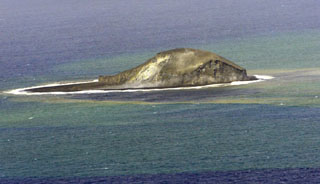Report on Home Reef (Tonga) — October 1984
Scientific Event Alert Network Bulletin, vol. 9, no. 10 (October 1984)
Managing Editor: Lindsay McClelland.
Home Reef (Tonga) Ships steam through pumice SE of Fiji
Please cite this report as:
Global Volcanism Program, 1984. Report on Home Reef (Tonga) (McClelland, L., ed.). Scientific Event Alert Network Bulletin, 9:10. Smithsonian Institution. https://doi.org/10.5479/si.GVP.SEAN198410-243080
Home Reef
Tonga
18.992°S, 174.775°W; summit elev. -10 m
All times are local (unless otherwise noted)
While traveling southeast of Fiji in May, June, and July, Dutch ships encountered rafts of floating pumice, probably from the March eruption of Home Reef.
On 15 May between 0100 and 0530, the MV Amanda Smits traveled through floating pumice from 18.10°S, 178.90°E to 18.78°S, 178.17°E, about 675 and 740 km WNW of Home Reef. The pumice ranged in size "from grit to large dice".
A volunteer meteorological observer aboard the MV Nedlloyd Alkmaar reported that the vessel first encountered pumice on 8 June at 0800 at 21.58°S, 177.85°W (about 430 km SW of Home Reef). Steaming on a course of 282° (slightly N of W), the ship continued to pass through pumice rafts of varying density for nearly 280 km, with the last observation on 8 June at 1800 at 21.03°S, 179.53°E (about 635 km WSW of Home Reef). Pumice fragments ranged in size from "fine grit" to about 10 cm in diameter. Live shellfish up to 1 cm across that looked like mussels were attached to some pumice fragments.
The MV Nedlloyd Barcelona sailed through small amounts of pumice 21 July; her positions at 0700 and at 1300 were 22.4°S, 178.7°E and 24.0°S, 178.7°E, about 775 and 875 km SW of Home Reef. Pumice fragments reached a maximum size of 2-3 cm and were aligned in E-W strands up to several hundred meters long.
Geological Summary. Home Reef, a submarine volcano midway between Metis Shoal and Late Island in the central Tonga islands, was first reported active in the mid-19th century, when an ephemeral island formed. An eruption in 1984 produced a 12-km-high eruption plume, large amounts of floating pumice, and an ephemeral 500 x 1,500 m island, with cliffs 30-50 m high that enclosed a water-filled crater. In 2006 an island-forming eruption produced widespread dacitic pumice rafts that drifted as far as Australia. Another island was built during a September-October 2022 eruption.
Information Contacts: L. Mahieu, Royal Netherlands Meteorological Inst.

